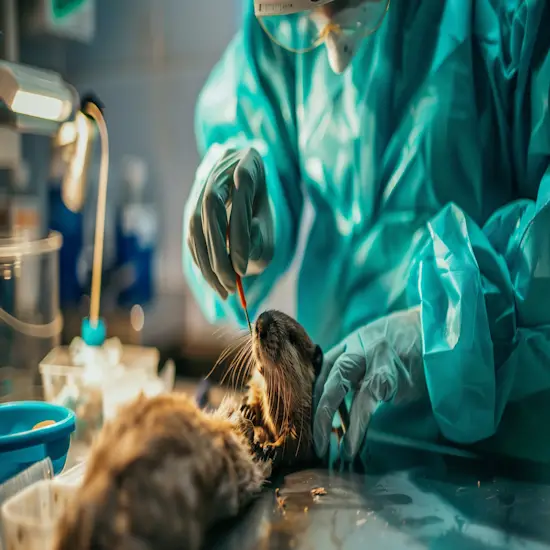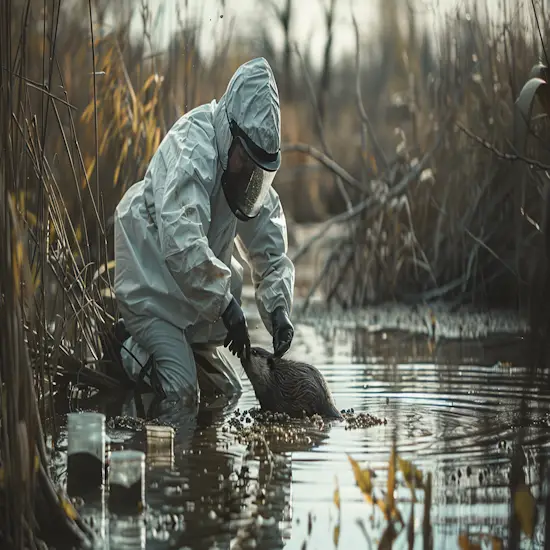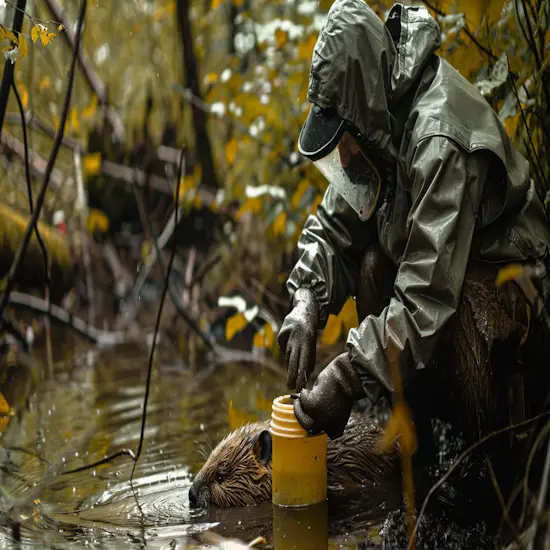Disclosure: We may earn commissions if you purchase products after clicking on a link from our site.
Do you want to learn how to extract castoreum from beavers? Imagine trying to extract a single drop of water from a vast ocean; that’s the delicate task of extracting castoreum from beavers. As you observe the intricate process of locating the castor sac and sedating the beaver, you realize the importance of precision and care in this procedure. But what happens next after the extraction?
In this article, we discuss the process of extracting castoreum from beavers and how to handle and take care of the beaver and the castoreum.

Table of Contents
Key Takeaways
- Locate the castor sac near the beaver’s reproductive organs.
- Sedate the beaver for extraction with proper sedative dosage.
- Extract castoreum gently to preserve quality.
- Handle the beaver carefully for humane harvesting.
- Follow proper techniques and ethical considerations throughout the process.

Understanding Castoreum
Understanding Castoreum involves recognizing its unique properties and origins in the castor sacs of beavers. Castoreum is a substance found in the castor sacs of both male and female beavers, located near the base of the tail. This secretion is used by beavers to mark their territory and communicate with other beavers.
The castor sacs produce castoreum through a complex process involving the combination of urine, glandular secretions, and anal gland excretions. This mixture undergoes a chemical transformation, resulting in a substance that has a strong, musky odor.
In the perfume and flavor industries, castoreum is valued for its unique scent profile, often described as leathery, animalic, and warm. It’s used as a fixative in perfumes, adding a long-lasting depth to fragrances. Additionally, castoreum is employed as a flavoring agent in certain food products, providing a rich and slightly sweet taste.

Harvesting Castoreum from Beavers
To harvest castoreum from beavers, you’ll need to locate the castor sac, sedate the beaver, and extract the castoreum. It’s essential to follow these steps carefully to guarantee the humane harvesting of the substance. Proper techniques and ethical considerations are vital throughout the process.
Locating the Castor Sac
To locate the Castor sac for harvesting castoreum from beavers, identify the small gland located near the reproductive organs in the beaver. The Castor sac is a small, oval-shaped gland situated close to the base of the tail.
When looking for it, pay attention to its location near the beaver’s anus and genital area. The sac contains the valuable substance known as castoreum, which is used in various applications like perfumes and flavorings.
Gently part the fur in this region to expose the Castor sac. It’s essential to handle the beaver carefully and avoid causing any harm during the extraction process. Once you have located the sac, you can proceed with the extraction of the castoreum.
Sedating the Beaver
To sedate the beaver for harvesting castoreum, carefully administer the appropriate dosage of sedative to guarantee a calm and safe extraction process. Be sure to use a sedative that’s approved for use in animals and follow the recommended dosage based on the beaver’s size and weight.
It’s essential to monitor the beaver closely after sedation to make sure it remains stable throughout the extraction procedure. Remember, the goal is to keep the beaver relaxed and comfortable during the process to minimize stress and any potential risks.
Extracting the Castoreum
When extracting castoreum from beavers, maintain a gentle and careful approach to preserve the quality of the substance.
Start by locating the castor sacs near the beaver’s anus. Make a small incision to access the sacs without damaging them. Gently squeeze the sacs to extract the castoreum, which will appear as a thick, yellowish substance.
Use a clean container to collect the castoreum, ensuring no contaminants come into contact with it. Once you have gathered a sufficient amount, carefully seal the container to prevent any leakage or evaporation.

Purification and Processing
Now, you’ll learn about the steps involved in purifying and processing castoreum. First, filtration is used to remove impurities and particles from the substance. Then, distillation separates the desired components based on their boiling points.
Filtration
Filtering the extracted castoreum from beavers is a crucial step in its purification and processing. To guarantee the purity of the substance, follow these steps:
- Initial Straining: Pass the extracted castoreum through a fine mesh or cheesecloth to remove any large particles or debris.
- Gravity Filtration: Let the liquid pass through a filter paper under the force of gravity to separate out smaller impurities.
- Activated Charcoal Filtration: Use activated charcoal to absorb remaining impurities and colorants from the castoreum.
- Final Filtration: Finish the process by passing the liquid through a micron filter to achieve a clear and purified castoreum solution.
Distillation
To purify and process castoreum further, distillation is a key method used in the extraction process. During distillation, the castoreum mixture is heated to separate its components based on their different boiling points.
The heat causes the volatile compounds in castoreum to vaporize, rise, and then condense back into liquid form. This process helps to isolate the desired substances from the rest of the mixture, resulting in a more concentrated and purified form of castoreum.
Chemical Analysis
When focusing on the Chemical Analysis aspect of castoreum purification and processing, the examination of its components plays a critical role in guaranteeing the quality and suitability of the final extract for various applications.
Here’s a simple guide to the chemical analysis process:
- Identification: Determine the specific compounds present in the castoreum.
- Quantification: Measure the amounts of each component to understand their concentrations.
- Purity Assessment: Evaluate the purity of the extract to make sure it meets industry standards.
- Quality Control: Conduct tests to check for any impurities or contaminants that could impact the final product.

Safety Precautions
Make sure to wear protective gear when handling castoreum to prevent any potential skin irritation or allergic reactions. Always follow proper handling procedures to guarantee your safety and the integrity of the extraction process.
Additionally, consider ethical considerations when extracting castoreum to respect the well-being of the beavers.
Protective Gear
Wear appropriate protective gear when extracting castoreum from beavers to guarantee your safety. Here are some essential items to take into account:
- Gloves: Use thick, durable gloves to protect your hands from bites and scratches.
- Safety Goggles: Shield your eyes from any potential splashes or debris during the extraction process.
- Coveralls or Apron: Wear protective clothing to prevent direct contact with the beaver and its surroundings.
- Boots: Opt for sturdy, waterproof boots to keep your feet dry and protected from any hazards on the ground.
Proper Handling
To guarantee your safety when handling beavers for castoreum extraction, prioritize understanding their behavior and handling techniques. Beavers are generally shy creatures but can become aggressive if they feel threatened. Approach them calmly and avoid sudden movements to prevent spooking them.
When handling a beaver, make sure to wear thick gloves to protect yourself from potential bites or scratches. Always maintain a safe distance from their powerful teeth and be cautious around their tail, which they may use as a defense mechanism.
If you need to restrain a beaver, do so gently and without causing harm. By being aware of their behavior and using proper handling techniques, you can minimize the risk of accidents and guarantee a safe extraction process.
Ethical Considerations
Considering the well-being of the beavers during the extraction process is paramount to guaranteeing ethical considerations and implementing safety precautions. To secure the ethical treatment of beavers and maintain safety standards, follow these guidelines:
- Minimize Stress: Handle beavers gently to reduce stress levels during the extraction process.
- Regular Monitoring: Keep a close eye on the beavers’ behavior and overall health throughout the extraction procedure.
- Proper Restraint: Use appropriate techniques to safely restrain the beavers without causing harm.
- Qualified Personnel: Ensure that individuals performing the extraction are trained and experienced in handling beavers ethically and safely.

Alternative Methods for Obtaining Castoreum
If you’re looking for alternatives to extracting castoreum from beavers, two promising options to explore are synthetic production and establishing beaver farms.
Synthetic production involves creating castoreum in a lab setting, mimicking the natural substance without involving beavers.
On the other hand, beaver farms could potentially provide a sustainable and ethical source of castoreum by raising beavers specifically for this purpose.
Synthetic Production
Exploring synthetic production methods is a practical approach for obtaining castoreum as an alternative to extracting it from beavers. By utilizing laboratory techniques, scientists can replicate the compounds found in natural castoreum, ensuring a cruelty-free and sustainable source of this valuable substance. Here are four key benefits of synthetic production:
- Ethical: Eliminates the need to harm beavers for castoreum extraction.
- Consistent Quality: Allows for precise control over the composition and purity of the product.
- Sustainable: Reduces the environmental impact associated with traditional harvesting methods.
- Cost-Effective: Offers a more efficient and economical way to produce castoreum on a larger scale.
Beaver Farms
Setting up beaver farms is a viable alternative method for obtaining castoreum as a sustainable and ethical source of this valuable substance. By raising beavers in controlled environments, you can guarantee a humane process that doesn’t harm wild populations. Here is a comparison between traditional wild harvesting and beaver farming:
| Aspect | Wild Harvesting | Beaver Farms |
|---|---|---|
| Sustainability | Variable | Sustainable |
| Ethics | Questionable | Ethical |
| Control | Minimal | High |
| Cost | Moderate | Initial setup |
| Yield | Inconsistent | Stable |
Consider the benefits of beaver farms for a reliable and responsible source of castoreum.
The Bottom Line
How to extract castoreum from beavers is a delicate process. There are several different ways to extract castoreum from beavers. In this article, we shared information on how to extract castoreum from beavers.
If you want to learn how to deter beavers from your yard, then read this article. Additionally, you can also read how to hunt beavers to improve your beaver hunting skills.
